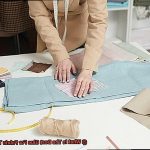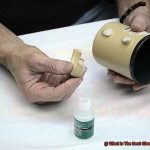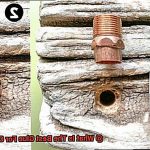Welcome to our blog post dedicated to finding the best adhesive for silicone to silicone.
If you’ve ever dabbled in the world of silicone, you know that finding an adhesive that actually sticks can be a real headache. Whether you’re a DIY enthusiast or just need to fix something, having the right adhesive is crucial when it comes to working with this unique material.
But fear not. We’ve done all the legwork and research for you, so you can sit back and relax while we reveal the ultimate adhesive that guarantees a strong and long-lasting bond.
So, if you’re itching to find out which product will save your silicone projects from falling apart, keep reading.
Adhesive Options for Bonding Silicone to Silicone
Contents
- 1 Adhesive Options for Bonding Silicone to Silicone
- 2 Two-Part Silicone Adhesives: Advantages and Uses
- 3 Cyanoacrylate Adhesives: Benefits and Considerations
- 4 Primers for Enhancing Adhesion Strength
- 5 Choosing the Right Adhesive for Bonding Silicone to Silicone
- 6 Preparing Surfaces for Bonding
- 7 Applying and Curing the Adhesive
- 8 Conclusion
Silicone, with its remarkable resistance to heat, moisture, and chemicals, is a popular material for various applications. However, bonding silicone to silicone requires the right adhesive to ensure a strong and durable bond. In this article, we will explore the adhesive options available and the important considerations when selecting an adhesive for this specific purpose.
Adhesive Options:
- Silicone-Based Adhesive: Specifically designed for bonding silicone materials, silicone-based adhesives offer excellent adhesion strength. They are resistant to high temperatures, water, and chemicals, making them ideal for various applications.
- Cyanoacrylate Adhesive: Commonly known as super glue, cyanoacrylates provide fast and strong adhesion. To enhance adhesion when bonding silicone to silicone, it is recommended to use a primer specially designed for silicone surfaces.
- Epoxy Adhesive: Offering excellent strength and durability, epoxy adhesives can withstand high temperatures and provide a strong bond between silicone surfaces. Look for epoxy adhesives formulated specifically for bonding silicone materials.
- UV-Curable Adhesive: These adhesives cure and form a strong bond when exposed to ultraviolet light. They offer fast curing times and good strength. However, long-term exposure to sunlight may cause degradation over time.
![]()
Considerations:
- Application Requirements: Consider factors such as temperature resistance, flexibility, and chemical resistance when selecting an adhesive. Different applications may have specific requirements that need to be met by the chosen adhesive.
- Surface Preparation: Prior to bonding, ensure that the surfaces are clean, dry, and free from contaminants or oils that may interfere with the adhesive bond. Roughening the surfaces slightly using sandpaper can improve bonding.
- Compatibility: Not all adhesives are suitable for bonding silicone to silicone. Test the adhesive on a small area before proceeding with the full bonding process to ensure it provides a strong bond and adheres well to the smooth silicone surface.
- Manufacturer’s Instructions: Follow the manufacturer’s instructions regarding mixing ratios, application methods, and curing times to ensure optimal results.
Two-Part Silicone Adhesives: Advantages and Uses
When it comes to bonding silicone surfaces, the answer lies in two-part silicone adhesives. These versatile adhesives are designed to create a bond that can withstand the toughest challenges. From high temperatures to harsh chemicals, these adhesives have got you covered.
Exceptional Strength and Durability:
Imagine a bond so strong that it can withstand extreme conditions without flinching. Two-part silicone adhesives possess this superpower. Once cured, they form an unbreakable bond that can brave the harshest environments. Whether it’s the scorching heat of an engine or the dampness of a bathroom, these adhesives will hold their ground.
Flexibility at Its Finest:
Flexibility is vital when bonding two silicone surfaces. Two-part silicone adhesives offer excellent flexibility, allowing them to move and flex with the materials they bond. This prevents cracks or breakage in the bond line, ensuring a long-lasting and reliable connection.
Chemical Resistance for the Win:
Who wants an adhesive that crumbles at the first sight of chemicals? Not us. Two-part silicone adhesives are chemical warriors. They fearlessly face solvents, oils, acids, and bases without losing their adhesive prowess. No matter what chemicals come their way, these adhesives will stand tall and strong.
Electrical Insulation for Sensitive Souls:
If you work with electronic components, you know how crucial electrical insulation is. Two-part silicone adhesives excel in this area. They provide excellent electrical insulation properties, making them perfect for bonding connectors, sensors, circuit boards, and other sensitive electronic equipment. Say goodbye to moisture-induced electrical mishaps.
Endless Possibilities in Various Industries:
Two-part silicone adhesives are not just another glue; they play a pivotal role in multiple industries. In the automotive world, they bond silicone hoses, engine mounts, and gaskets, thanks to their high-temperature resistance and flexibility.
The aerospace industry relies on these adhesives to seal and bond silicone components that experience extreme temperatures and environmental conditions.
Electronics manufacturers trust them to protect their delicate components from moisture and other environmental factors.
Even the medical device industry embraces them for bonding and sealing medical-grade silicone components.
Cyanoacrylate Adhesives: Benefits and Considerations
Cyanoacrylate adhesives, also known as super glue or instant glue, are the superheroes of the adhesive world when it comes to bonding silicone to silicone surfaces. These remarkable adhesives offer a multitude of benefits and considerations to keep in mind.
One of the key advantages of cyanoacrylate adhesives is their lightning-fast curing time. While other glues may take hours to dry, cyanoacrylate adhesives can bond your silicone surfaces in a matter of seconds. Whether you’re fixing a broken silicone phone case or working on a craft project that demands immediate bonding, these adhesives are your best bet for quick and efficient results.
Strength and durability are also at the forefront of the benefits offered by cyanoacrylate adhesives. Once cured, these adhesives form an incredibly strong bond that can withstand high temperatures, moisture, and various environmental conditions. No need to worry about your glued surfaces falling apart when exposed to heat or water – cyanoacrylate adhesives have got you covered.
But wait, there’s more. Cyanoacrylate adhesives are not limited to bonding silicone to silicone surfaces alone. They can also be used to bond other materials like metal, plastic, rubber, and even some porous surfaces. Whether you’re working on a DIY project or repairing household items, these versatile adhesives will rise to the occasion.
However, it’s important to note that not all cyanoacrylate adhesives are suitable for bonding silicone. To ensure optimal results, you need to choose a specific formula designed for this purpose. Additionally, proper surface preparation is crucial. Your silicone surfaces should be clean, dry, and free from any contaminants or oils that may hinder the bonding process.
While cyanoacrylate adhesives offer many benefits, there are a few considerations to keep in mind. These adhesives can be brittle and may not be suitable for applications where flexibility is required. Additionally, they have a limited gap-filling capability, so they work best when bonding two flat and smooth surfaces together.
Lastly, it’s important to handle cyanoacrylate adhesives with caution. These powerful adhesives can bond skin or other materials unintentionally. To avoid any mishaps, it is recommended to wear gloves and work in a well-ventilated area.
Primers for Enhancing Adhesion Strength
Primers are the unsung heroes in the world of adhesives, capable of revolutionizing your adhesive projects by enhancing adhesion strength between silicone surfaces. In this article, we will explore the role of primers and how they can unleash the true potential of your bond.
Preparing for Success: Understanding the Role of Primers
Primers act as a bridge between the adhesive and the silicone surface, ensuring a reliable and long-lasting bond. Their main function is to remove contaminants that can hinder adhesion, such as oils, dirt, or release agents. By preparing the surface, primers create a clean canvas for the adhesive to work its magic.
Choosing the Perfect Primer:
Not all primers are created equal. Selecting the right one is crucial for optimal results. Considerations such as the type of silicone being bonded, the specific adhesive being used, and the intended application or environment play a vital role in primer selection. Manufacturers offer various formulations tailored for different silicone materials, including high-consistency rubber (HCR), liquid silicone rubber (LSR), and room temperature vulcanizing (RTV) silicone.
Mastering the Application Technique:
Proper application is key to maximizing primer effectiveness. Before applying the primer, ensure that the silicone surface is thoroughly cleaned and dried. Use solvents like isopropyl alcohol or acetone to remove any impurities. Once clean, apply the primer using a brush, roller, or spray, following the manufacturer’s instructions regarding drying time and application method.
The Bonding Symphony: Primer and Adhesive Working in Harmony
With the primer in place, it’s time to introduce your adhesive to the stage. The primer creates a chemical bond with both the silicone surface and the adhesive, enhancing adhesion strength. This combination results in a robust bond that can withstand various environmental factors, ensuring the longevity of your project.
Primers Beyond Silicone:
Primers excel in enhancing adhesion strength between silicone surfaces, but their versatility extends beyond silicone-to-silicone bonding. They can also be used to promote bonding between silicone and other materials like metals, plastics, or fabrics, making them invaluable for multi-material assemblies.
Choosing the Right Adhesive for Bonding Silicone to Silicone
Choosing the right adhesive for bonding silicone to silicone is crucial to ensure a strong and durable bond. Silicone is known for its smooth and nonporous surface, which makes it challenging for adhesives to adhere to. However, with the proper adhesive and surface preparation, you can achieve a bond that will withstand even the toughest conditions.
Here are some key steps to consider when selecting the right adhesive:
- Silicone-based adhesives: These adhesives are specifically formulated with silicone polymers, making them ideal for bonding silicone surfaces. They offer excellent flexibility and can withstand high temperatures, making them suitable for applications in extreme conditions.
- Adhesives with primers or activators: These additives improve adhesion properties by promoting chemical bonding between the adhesive and the silicone surface. Apply them before the adhesive for optimal results.
- Cyanoacrylate adhesives (aka super glues): Not all cyanoacrylate adhesives are suitable for silicone bonding due to silicone’s low surface energy. Choose a cyanoacrylate adhesive specifically formulated for silicone to ensure compatibility.
Now that you know your options, let’s discuss surface preparation. Clean the surfaces thoroughly using isopropyl alcohol or a specialized silicone cleaner to remove any dirt, dust, or oils that could hinder adhesion. Additionally, roughen the surface slightly with sandpaper or an abrasive pad to increase the bonding surface area and improve mechanical adhesion.
When applying the adhesive, follow the manufacturer’s instructions precisely. Different adhesives may require specific techniques or curing methods. Precision is key to achieving a strong bond.
Consider the requirements of your project, such as temperature resistance, flexibility, and chemical resistance, when selecting an adhesive. You want an adhesive that can handle the challenges it will face.
If you’re still unsure about which adhesive to choose, consult with adhesive experts or conduct tests to find the perfect adhesive for your silicone-to-silicone bonding adventure. These experts can provide valuable insights based on their experience.
Preparing Surfaces for Bonding
![]()
In the world of bonding, the art lies in the preparation. Just like a skilled artist meticulously prepares their canvas before creating a masterpiece, properly preparing surfaces is the secret to achieving unbreakable bonds. In this captivating guide, we will take you on a journey through the essential steps for preparing surfaces for bonding, unveiling the secrets that will ensure your connections stand the test of time.
Step 1: The Power of Purity
Cleanliness reigns supreme when it comes to preparing surfaces for bonding. Before attempting any adhesive magic, banish dirt, grease, and other contaminants from the stage. Armed with isopropyl alcohol or a mild detergent, cleanse the surfaces thoroughly. Only proceed to the next act when they are immaculately dry.
Step 2: Embrace Imperfection
Smooth and nonporous surfaces can be stubborn foes in the battle for adhesion. To conquer their resistance, you must roughen their tranquil facade. Summon your sandpaper or sanding block and gently etch a textured surface that beckons the adhesive’s embrace.
Step 3: Dust Off the Drama
As you strive for perfection, don’t let the drama of dust and debris steal the spotlight. Employ compressed air or a soft brush to sweep away any remnants of chaos that may have gathered during the roughening ritual. Leave the stage clean and ready for the next act.
Step 4: Primer, the Unsung Hero
In certain tales of bonding, especially those featuring smooth silicone surfaces, a hero named primer emerges from the shadows. This magical elixir enhances adhesion by forging a bond between silicone and adhesive. Choose a primer crafted specifically for silicone bonding and adhere to its application instructions with unwavering discipline.
Step 5: Bid Farewell to Moisture
Moisture, an unwelcome antagonist, threatens to sabotage your bond’s grand finale. Ensure the surfaces are utterly devoid of this treacherous foe before applying the adhesive. Whether it be a gentle caress of a dry cloth or the touch of gentle heat, bid moisture farewell and let your bond flourish.
Applying and Curing the Adhesive
Today, we will explore the step-by-step process to achieve a strong and durable bond. So, put on your safety goggles and let’s dive in.
- Surface Preparation: A clean surface is crucial for a successful bond. Begin by thoroughly cleaning the silicone surfaces using isopropyl alcohol or acetone. This will remove any dirt, dust, or grease that could compromise the adhesive’s effectiveness.
- Applying the Adhesive: Choose a high-quality silicone adhesive specifically designed for silicone-to-silicone bonding. Apply the adhesive evenly on both surfaces using a brush, nozzle, or dispenser – whatever suits your preference.
- Bonding Time: Once the adhesive is applied, carefully bring the silicone surfaces together. Take a moment to ensure proper alignment before joining them firmly. Refer to the manufacturer’s instructions for the recommended bonding time – this will allow the adhesive enough time to set and work its magic.
- Curing Process: The curing process is when our adhesive hardens and solidifies. Most silicone adhesives cure through a chemical reaction with moisture in the air, known as moisture cure adhesives. Keep an eye on temperature and humidity conditions, as they can affect the curing time and bonding strength.
- Temperature and Humidity Considerations: It is crucial to work within the recommended temperature range during the curing process. Extreme temperatures or high humidity levels can lead to glue meltdowns or slow curing times – something we definitely want to avoid.
- Post-Curing Precautions: After the initial curing period, it’s time for some post-curing precautions. Allow additional time for post-curing to ensure maximum bond strength and durability. During this stage, avoid putting stress or load on the bonded joint – let it fully set and strengthen.
yDEQLKW1HNk” >
Conclusion
In conclusion, the quest for the perfect adhesive to bond silicone to silicone can be quite the challenge. But fear not. Armed with the right knowledge and understanding of your options, you can create a bond that’s as tough as nails and built to withstand even the harshest conditions.
When it comes to bonding silicone to silicone, there are several viable adhesive choices at your disposal. Silicone-based adhesives, cyanoacrylate adhesives, epoxy adhesives, and UV-curable adhesives all have their own unique advantages and considerations. It’s crucial to select the adhesive that aligns perfectly with your specific application requirements.
But wait, there’s more. Primers also play a pivotal role in enhancing adhesion strength between silicone surfaces. Think of them as the bridge that connects your adhesive to the surface, creating an ideal canvas for optimal bonding. Choosing the right primer and applying it with finesse can significantly level up your overall bond strength.
Of course, we can’t forget about surface preparation – a critical step in achieving a successful bond. Give those surfaces a thorough cleaning, add some grit by lightly roughening them with sandpaper or an abrasive pad, and make sure there’s no trace of moisture or contaminants lurking around. These steps are non-negotiable if you want a bond that stands strong.
Last but certainly not least: follow instructions like they’re gospel. The manufacturer knows best when it comes to application techniques and curing times. Don’t ignore temperature and humidity considerations during the curing process either – they could make or break your bond.
So there you have it – armed with these factors in mind and armed with the perfect adhesive and primer combo for your needs, you’ll be well on your way to achieving a bond that’s nothing short of extraordinary.





